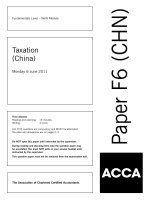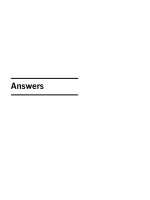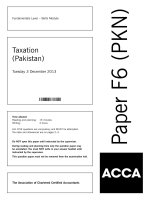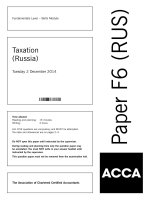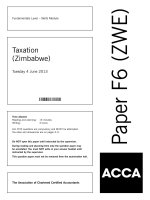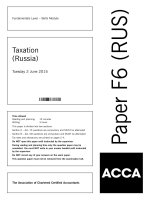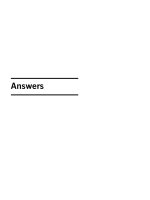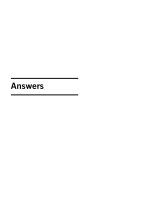ACCA f6 taxation romania 2012 dec question
Bạn đang xem bản rút gọn của tài liệu. Xem và tải ngay bản đầy đủ của tài liệu tại đây (225.86 KB, 11 trang )
Taxation
(Romania)
Tuesday 4 December 2012
Time allowed
Reading and planning:
Writing:
15 minutes
3 hours
ALL FIVE questions are compulsory and MUST be attempted.
Tax rates and allowances are on pages 2–5.
Do NOT open this paper until instructed by the supervisor.
During reading and planning time only the question paper may
be annotated. You must NOT write in your answer booklet until
instructed by the supervisor.
This question paper must not be removed from the examination hall.
The Association of Chartered Certified Accountants
Paper F6 (ROM)
Fundamentals Level – Skills Module
SUPPLEMENTARY INSTRUCTIONS
1.
2.
3.
Calculations and workings should be made to the nearest lei, unless instructed otherwise.
All apportionments should be made to the nearest month.
All workings should be shown.
TAX RATES AND ALLOWANCES
The following tax rates and allowances should be used when answering questions.
Personal income tax
General tax rate
16%
Income from employment
Benefits
Limit for non-taxable gifts
Limit for non-taxable voluntary pension contributions paid by the employer
Deductions
Deduction allowed for voluntary pension contributions paid by the employee
150 lei/person/occasion
€400/year
€400/year
Personal deduction
Number of dependent
persons for the taxpayer
Below 1,000
Monthly gross income (MI) – lei
Between 1,000 and 3,000
Above 3,000
0 persons
250
⎛
MI – 1, 000 ⎞
250 x ⎜1 –
⎝
2, 000 ⎟⎠
0
1 person
350
⎛
MI – 1, 000 ⎞
350 x ⎜1 –
⎝
2, 000 ⎟⎠
0
2 persons
450
⎛
MI – 1, 000 ⎞
450 x ⎜1 –
⎝
2, 000 ⎟⎠
0
3 persons
550
⎛
MI – 1, 000 ⎞
550 x ⎜1 –
⎝
2, 000 ⎟⎠
0
4 persons and more
650
⎛
MI – 1, 000 ⎞
650 x ⎜1 –
⎝
2, 000 ⎟⎠
0
Note: The value of the personal deduction resulting from the calculation should be rounded up to 10 (e.g. both 212
and 217 should be rounded to 220).
Income from the sale of immovable property owned by an individual
For immovable properties sold in less than three years from their acquisition
Income
Tax rate
Up to 200,000 lei
3%
Above 200,000 lei
6,000 lei + 2% of the amount exceeding 200,000 lei
For immovable properties sold in a timeframe longer than three years from their acquisition
Income
Tax rate
Up to 200,000 lei
2%
Above 200,000 lei
4,000 lei + 1% of the amount exceeding 200,000 lei
Income from renting
Lump-sum deductible expenses quota
25%
2
Copyright income
Lump-sum deductible expenses quota for:
– monumental works of art
– other
Tax rate for withheld prepayments
25%
20%
10% or 16%
Self-employed income
The allowance accepted for public institutions’ employees
The limit of deductibility for protocol expenses
The limit of deductibility for compulsory subscription expenses
The limit of deductibility for subscription expenses
other than the compulsory ones
The limit of deductibility for social expenses
Reference interest rate set by the Romanian National Bank for loans
denominated in lei
Tax rate for withheld prepayments
13 lei/day/person
2%
5%
2%
2%
6·25%
10% or 16%
Investment income
Tax rate for capital gains from the sale of shares
Tax rate for interest received by individuals
Tax rate for dividends received by individuals
16%
16%
16%
Prize income
Tax rate for prize income
Non-taxable value
16%
600 lei/day/prize
Pension income
Non-taxable pension income
1,000 lei
Corporate income tax
General tax rate
Minimum tax applicable to night clubs, discotheques, casinos
or sport betting activities
Reference interest rate set by the Romanian National Bank
for loans denominated in lei
Maximum accepted interest rate set by the Tax Code for loans
denominated in foreign currency
Inflation rate for prepayments of corporate income tax in 2011
The allowance accepted for public institutions’ employees
Maximum value of deductible expenses for employees:
– voluntary pension contributions
– private healthcare insurance contributions
Maximum value of deductible expenses for subscriptions to
non-profit organisations other than those which are compulsory or due
to the chambers of commerce and to employers’ organisations
The limit of deductibility for protocol expenses
The limit of deductibility for social expenses
Maximum value of tax credit for sponsorship expenses
3
16%
5%
6·25% p.a.
6% p.a.
3·2% p.a.
13 lei/day/person
€400/tax year/employee
€250/tax year/employee
€4,000/year
2%
2%
20% of the corporate income tax
but no more than 3‰ of sales
revenue
[P.T.O.
Corporate tax for very small companies
Tax rate
3%
Straight-line depreciation periods (for tax and accounting purposes)
Class of asset
Buildings
Machines and equipment
Computers
Period in years
50
10
3
Note: The straight-line depreciation method for the above periods should be used in all cases, except where a question
specifically indicates another method and/or period is to be used.
Tax on dividends paid to legal persons
For dividends paid to legal persons resident in Romania, EU or EFTA countries
For dividends paid to other non-residents
16% or 0%
16%
Social security and other insurance contributions
Employed persons
Social security fund
Healthcare insurance fund
Unemployment fund
Work accident fund
Health insurance indemnities fund
Fund for guaranteeing salary payments
Employee
10·5%*
5·5%
0·5%
–
–
–
Employer
20·8%**
5·2%
0·5%
0·15%–0·85%***
0·85%
0·25%
Contributions withheld from income for persons with professional activities
Social security fund
10·5%*
Unemployment fund
0·5%*
Contributions payable directly by the persons with professional activities, where applicable
Healthcare insurance fund
5·5%
Self-employed persons
Social security fund
Healthcare insurance fund
Unemployment fund
Work accident fund
Health insurance indemnities fund
Medium monthly earnings
Minimum monthly salary
The limit of gifts to which social
contributions do not apply
31·3%
5·5%
1%
0·15%–0·85%***
0·85%
2,022 lei
670 lei
150 lei/person/occasion
* The taxable base shall not exceed 5 times the medium monthly earnings
** The taxable base shall not exceed 5 times the medium monthly earnings multiplied by the number of employees
*** The exact value will be specified in the question, where necessary.
Note:
These rates should be used in answering the questions, irrespective of the time period the question refers to.
4
Value added tax (VAT)
Standard rate
Reduced rates
Annual threshold for VAT registration
Annual threshold for monthly tax period
24%
9% and 5%
€35,000
€100,000
Exchange rate
€1 = 4·20 lei
Euro/lei
Note: This rate should be used in all cases except where a question specifically indicates another rate is to be used.
Interest and penalties
Interest rate for late tax payments
Penalty level for late tax payments
– for payments made in the first 30 days after maturity
– for payments made between 31 and 90 days after maturity
– for payments made more than 90 days after maturity
5
0·04%/day
0%
5%
15%
[P.T.O.
ALL FIVE questions are compulsory and MUST be attempted
1
Rose S.A., a company established in Oradea, Romania, in September 2011, specialises in various construction works.
Rose S.A. has a share capital of 1,000,000 lei which is owned 80% by Bush Co, a company based in Hungary, the
remaining 20% being owned equally by 30 individuals, all of whom are resident in Romania. In the first period of
trading from September to December 2011, Rose S.A. recorded a tax loss of 87,000 lei and an accounting loss of
120,000 lei, which has worried investors.
The general manager of Rose S.A. has computed the corporate income tax for 2012 as below.
Lei
7,560,000
6,422,500
––––––––––
1,137,500
182,000
––––––––––
955,500
––––––––––
Total revenues
Total expenses (excluding corporate income tax)
Gross profit before tax
Corporate income tax
Net income (after tax)
The general manager intends to announce to shareholders that the 2011 loss is fully covered and that Rose S.A. may
even distribute dividends after the allocation to the legal reserve of 113,750 lei is made. According to a shareholders’
decision of 2011, each year the company will allocate 10% of its gross profit to the legal reserve, but not exceeding
the limit imposed by the law for the legal reserve, of 20% of share capital.
The general manager has provided the following additional information on total revenues and total expenses for 2012:
(1) Sales revenue is 6,230,000 lei. Other operational taxable revenues are 1,310,000 lei.
(2) In September 2011, Rose S.A. bought 40% of the share capital of Bulb Co, a company based in Bulgaria. For
2011, Bulb Co distributed and paid the dividends to its shareholders on 10 April 2012. Rose S.A. received
dividend revenue of 20,000 lei. Bulb Co did not withhold any tax from these dividends.
(3) Rose S.A.’s premises are in a rented building. The rent contract was for four years from September 2011 until
August 2015. In April 2012, Rose S.A. renovated the premises and transformed its courtyard into a parking
space for ten cars. The value of works was 240,000 lei and Rose S.A. registered the whole value directly to
expenses. The ten parking spaces were to be occupied by Rose S. A.’s four company cars and the cars of clients.
On 30 November 2012, Rose S.A. ceased the rent contract as it had had some differences with the owner. Thus
Rose S.A. abandoned the investment and received no money from the owner for the improvements it had made.
Starting in December 2012, Rose S.A. rented other premises.
(4) The four company cars are leased by Rose S.A. under operating leases. Three of the cars are used by Rose S.A.’s
managers, while the fourth one is used by an engineer who has no management responsibilities. In 2012, Rose
S.A. changed the tyres for all four company cars for an amount of 2,000 lei/car and registered the amount in
expenses.
(5) Based on a written contract, according to the law, Rose S.A. sponsored the Architecture National Contest of
Romania organised by the Architecture University with 20,000 lei. Rose S.A. also made a donation of
20,000 lei to a person having a serious health problem.
(6) Rose S.A. received consultancy services from a Hungarian company which invoiced Rose S.A. 32,000 lei. The
consultancy services were provided from Hungary. Rose S.A. paid the full amount to the Hungarian company
which did not provide Rose S.A. with a certificate of fiscal residence. Thus Rose S.A. computed the withholding
tax using the gross-up formula and paid it to the state and registered it in expenses.
(7) Rose S.A.’s annual gross salary expense is 1,200,000 lei. According to the collective employment contract, Rose
S.A. pays a monthly subscription of 4,000 lei to a sports club, so its employees can relax and enjoy themselves.
Rose S.A. also paid 6,450 lei for training courses organised by certified trainers to improve the professional skills
of its employees, and paid 25,000 lei for health spa treatments for its employees. Rose S.A. has 25 employees.
None of these amounts were taxed at the employee level.
(8) Rose S.A. is a member of the Builders Professional Association to which it paid a subscription of 30,000 lei for
2012. It is not compulsory for Rose S.A. to be a member of this association, but it helps with employees’
networking and knowledge of the building sector.
6
(9) According to the rules established by the Builders Professional Association, Rose S.A. included in the contracts
with its clients a warranty clause of 100,000 lei. Being prudent, Rose S.A. included a provision expense of
150,000 lei in its 2012 total expenses.
(10) According to the decision of the general manager for the depreciation of its fixed assets, Rose S.A. uses the
accelerated method for accounting purposes and the straight-line method for tax purposes.
Rose S.A.’s shareholders have agreed that the net profit for 2012, after covering previous losses and the allocation to
the legal reserve, will be distributed as dividends.
Required:
(a) List the main standard adjustments that should be made by any corporate income tax payer to the accounting
profit for the purpose of calculating the corporate tax base.
(3 marks)
(b) Compute the corporate income tax due by Rose S.A. for 2012, making all changes necessary in respect of
the accounting legislation, Rose S.A.’s policies and the tax legislation.
Note: You should ignore any social contributions that may arise.
(c) Compute the maximum value of gross dividends that may be distributed by Rose S.A.
(19 marks)
(2 marks)
(d) Under each of the two scenarios below, compute the income tax due on the dividends distributed by Rose
S.A. from its 2012 profit and state the deadline for paying and declaring the tax if Bush Co (its major
shareholder) did not provide a certificate of fiscal residence or any other declaration, if
(i) the dividends are paid on 8 June 2013; and
(ii) the dividends are paid on 14 December 2014.
The total marks will be split equally between each part.
(6 marks)
(30 marks)
7
[P.T.O.
2
Mr and Mrs Iris have been married since 1980 and are located in Cluj, Romania. They have three sons: Paul, Andrei
and George. The Iris family registered the following revenues in 2012:
(1) Since 2008, Mrs Iris has been employed by Park SA, a company based in Jucu, a town 20 kilometres away from
Cluj. Mrs Iris’s employment revenues for 2012 comprise a monthly base salary of 2,200 lei. As Mr Iris has no
employment revenue, Mrs Iris asked her employer to consider all of their children in her care, if allowed by the
law. In 2012, Mrs Iris also received an inheritance from an aunt of 100,000 lei in cash.
(2) Mr Iris has revenues from a small self-employed business in the field of gardening services. Mr Iris applies the
real system in determining his income tax. He began this activity in 2012 when he estimated his net annual
income at 49,000 lei. At the end of 2012, he recorded the following values in the accounting books:
–
–
–
–
Gross revenues: 189,000 lei
Expenses for gardening materials: 78,000 lei
Acquisition in June 2012 of equipment (a lawn mower) at a cost of 12,000 lei
Other deductible expenses (including social contributions): 10,000 lei
Mr Iris tried to get some additional money by trading on the Bucharest Stock Exchange. During 2011, his
activities were not as successful as he had hoped and he registered a tax loss of 4,000 lei. During 2012, he
made only three transactions in the shares of Lavender S.A.:
(i) bought 10,000 shares for 3 lei/share in March 2012,
(ii) sold 3,000 shares at 4 lei/share in May 2012, and
(iii) sold the remaining 7,000 shares at 3·5 lei/share in November 2012.
(3) Paul, who is 30 years old, is a writer, so he usually earns intellectual property revenue. He has a contract with
a local magazine where he publishes an essay every week for which he receives monthly gross intellectual
property revenue of 14,000 lei. He has made no specific option as regards taxation in his contracts, so the
standard tax treatment applies.
(4) Andrei, who is 21 years old, is studying full time at the University of Bucharest. He has a scholarship of
400 lei/month from the University as he is a top student. Andrei receives the scholarship in every month of the
year. In December 2012, Andrei sold his own personal computer for 2,500 lei to have money for the New Year’s
Eve party.
(5) George, who is 18 years old, studies at the local high-school. He has no permanent revenues. In March 2012,
he participated in the Mathematics National Contest organised by the Ministry of Education and came first,
winning a prize of 2,000 lei. During the summer, he participated in some television contests where he won
different prizes as follows: 1,000 lei in June 2012, 2,800 lei in July 2012 and 4,000 lei in August 2012.
Required:
(a) State which incomes earned by the members of the Iris family are exempt from tax.
(2 marks)
(b) For each member of the Iris family, determine the total final income tax due for 2012 and, where applicable,
the prepayments of tax.
(23 marks)
(25 marks)
8
3
Tulip SRL is a company providing transport services for goods, which is established and registered for value added
tax (VAT) purposes in Romania. Tulip SRL has a monthly tax period for VAT and charges its clients 2·5 lei/km,
excluding VAT.
During the first quarter of 2012, Tulip SRL performed the following transport services:
Item
Service
Month of performance
Number of
kilometres
Invoiced to
1
Transport of goods within the
EU from Romania to France
January 2012
2,200
Grass SARL, a company
established and registered for
VAT purposes in France
2
Transport of goods from the
EU (Italy) to outside the EU
(North Africa)
January 2012
3,000
Leaf SA, a company
established and registered for
VAT purposes in Romania
3
Transport of goods in
Romania from Bucharest to
Pitesti
February 2012
130
Flower Co, a company
established in Russia
4
Transport of goods in
Romania from Bucharest to
Iasi
February 2012
400
Strain Ltd, a company
established and registered for
VAT purposes in Hungary
5
Transport of goods from
Russia (non-EU) to China
(non-EU)
March 2012
6,300
Pestle SRL, a company
established and registered for
VAT purposes in Romania
Tulip SRL also performed other transport services within Romania for which it did not issue any invoice, as it did not
receive payment for them:
(i)
Transport of some of its own assets from Bucharest to Arad (550 km), when Tulip SRL opened a branch in Arad
in January 2012;
(ii) Transport of the personal belongings of two of Tulip SRL’s shareholders, when they moved from Suceava to
Bucharest (500 km) in February 2012;
(iii) Transport of goods from Bucharest to Constanta (250 km) in March 2012 for Ground S.A., a company
established and registered for VAT purposes in Romania. Ground S.A. is Tulip SRL’s supplier of fuel. Thus,
Tulip SRL and Ground S.A. agreed that the value of the transport made by Tulip SRL for Ground S.A. would be
subtracted from the value of fuel sold by Ground S.A. to Tulip SRL and that Ground S.A. would invoice to
Tulip SRL only the difference, being an amount of 2.000 lei, exclusive of VAT.
Required:
(a) For each transport service provided and invoiced by Tulip SRL (items 1 to 5), state the place of supply of the
service and the amount of value added tax (VAT) that should be charged by Tulip SRL, giving reasons if no
VAT should be charged.
(9 marks)
(b) For each transport service not invoiced by Tulip SRL (items (i) to (iii)), state, giving reasons, whether or not
Tulip SRL should have issued an invoice or a self-invoice.
(3 marks)
(c) Considering the transactions performed by Tulip SRL (items 1 to 5), list the VAT returns and statements that
should be submitted by Tulip SRL, together with the deadlines for submitting them.
(3 marks)
(15 marks)
9
[P.T.O.
4
Daffodil SARL is a company established in France providing consultancy services. In January 2012, Daffodil SARL
signed a contract to provide consultancy services to Bouquet S.A., a company established in Romania. The duration
of the contract was for four months starting on 1 February 2012. The consultancy services were to be invoiced at a
monthly fixed value of 18,400 lei, exclusive of value added tax (VAT).
In order to perform the consultancy services, Daffodil SARL rented an apartment in Bucharest to use as an office from
Mrs Freesia, a Romanian citizen, for four months at a monthly rent of 4,000 lei starting on 1 February 2012. Daffodil
SARL sent two of its employees, who are both French citizens, from France to Romania to supply the consultancy
services to Bouquet S.A. The gross employment revenue of each employee is 5,100 lei per month. Daffodil SARL
pays social contributions and income tax for these employees in France.
In May 2012, Daffodil SARL signed another contract with a Romanian based company, Root SRL. Under this contract,
Daffodil SARL would provide consultancy services to Root SRL for 15 months starting on 1 June 2012, for a fixed
monthly fee of 20,500 lei, exclusive of VAT. Thus, Daffodil SARL extended the rent contract with Mrs Freesia until
September 2013. In May 2012, Daffodil SARL’s employees who came to Romania in February returned to France
and Daffodil SARL decided to employ two Romanian citizens in its office in Bucharest. The gross revenue for each of
these new employees is 5,100 lei per month. Daffodil SARL pays social contributions and income tax for these new
employees in France.
In 2012 Daffodil SARL’s accountant made a separate budget for its activity in Romania. According to this budget, only
the following expenses are considered as being directly linked to the Romanian activity:
–
–
–
–
–
the rent paid to Mrs Freesia plus utilities of 500 lei per month;
meals given in Bucharest to business partners of 3,200 lei;
the gross salaries of the employees working in Bucharest;
the social contributions due by the employer and paid in France for the employees of 1,500 lei per month per
employee; and
a 5,000 lei fine received from the French authorities for not declaring the activity in Romania to the French tax
administration.
Required:
(a) Explain how a permanent establishment is defined and state whether Daffodil SARL’s activity generates a
permanent establishment in Romania.
(3 marks)
(b) Assuming that Daffodil SARL would have declared a permanent establishment in Romania from February
2012, determine the corporate income tax due by this permanent establishment in 2012.
(5 marks)
(c) Explain how the tax residence of an individual is defined and state whether Daffodil SARL’s employees
brought to Romania in February 2012 will be considered resident in Romania.
(3 marks)
(d) Explain from when Daffodil SARL’s employees brought to Romania in February 2012 are liable to pay
personal income tax in Romania, and state the person liable to declare and pay the tax, together with the
deadline by which it should be paid.
(4 marks)
Note: Ignore any double taxation tax treaty that may apply in all parts of this question. Ignore any VAT implications.
(15 marks)
10
5
Mr Snowdrop is a Romanian citizen living in Ploiesti, Romania. Mr Snowdrop is a self-employed person, having a
small business trading in CDs and DVDs since 2010. Mr Snowdrop decided to use the system of income quotas for
paying his personal income tax. The Ploiesti tax administration approved this decision and communicated to
Mr Snowdrop that for 2012 the annual income quota is set at 8,400 lei. Mr Snowdrop has a cash register for issuing
fiscal receipts to his clients. Mr Snowdrop always received payment from clients at the moment of sale, but he did
not keep any evidence of his expenses.
In June 2013, Mr Snowdrop received a tax inspection that made a tax audit for the tax year 2012. The tax inspectors
analysed the fiscal receipts issued by Mr Snowdrop and established that Mr Snowdrop’s revenues during 2012 were
12,000 lei per month. Further to the tax inspection, on 1 July 2013, the tax administration issued and communicated
to Mr Snowdrop a tax decision stating the following:
(1) Mr Snowdrop’s revenue in 2012 was higher than the income quota, so Mr Snowdrop has to pay additional
income tax, which is to be calculated on the revenues that exceeded the income quota as Mr Snowdrop recorded
no expenses.
(2) Mr Snowdrop exceeded the value added tax (VAT) registration threshold, so he has to pay VAT for the revenues
recorded in 2012 after the date when Mr Snowdrop should have registered for VAT purposes.
(3) Mr Snowdrop should pay interest and penalties for not paying his taxes on time.
Required:
(a) Compute the prepayments of income tax and the final income tax due by Mr Snowdrop for 2012 using the
income quota system, and state the deadlines for declaring and paying the tax.
(2 marks)
(b) Determine the additional income tax to be paid by Mr Snowdrop for 2012 as calculated by the tax inspectors.
(2 marks)
(c) (i)
Determine when Mr Snowdrop should have requested to be registered for value added tax (VAT)
purposes, and calculate the VAT that Mr Snowdrop should have charged for the year 2012.
Note: The revenues of Mr Snowdrop should be considered as amounts exclusive of VAT; the exchange rate
for calculating the VAT threshold is 1 Euro = 3·3817 lei.
(4 marks)
(ii) Compute the total value of interest and penalties due by Mr Snowdrop on the VAT established by the
tax inspectors (as calculated in (i) above), if Mr Snowdrop pays the amount due on 10 July 2013.
(2 marks)
(d) Assuming Mr Snowdrop would like to appeal the decision of the tax administration, state the deadline and
competent authority for making the appeal together with the arguments against any wrong decision taken by
the tax inspectors.
(5 marks)
(15 marks)
End of Question Paper
11
